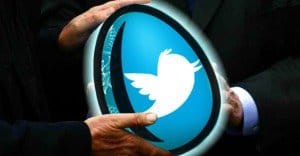 Written by ContentPowered.com
Written by ContentPowered.com
With the slow decline in Facebook organic reach, more businesses than ever are turning to Twitter as their primary means of networking and engaging with their fans. This is a great idea, but you really need to put some work into your profile before you can successfully build an audience. How can you attract followers if your account isn’t worth following? To make it worth their time:
Use a Good Profile Picture
Your profile picture is the most visible graphic associated with your profile. Yes, your background header may be larger, but it doesn’t show up as often. When users view their own feeds, they see your profile picture.
As a business, you have two primary options for a picture; your logo or a prominent person in your organization. It’s up to you which you choose, but remember that many users find it easier to converse with a person rather than a brand. On the other hand, if your public figure isn’t recognizable, you won’t end up with any benefit from name or face recognition.
In any case, avoid the default Twitter egg picture. It’s a sign of the newbie and the spammer, and you don’t want to look like either.
Use a Good Header Image
Your header image is only visible to users viewing your page, so it’s significantly less important than your profile picture. That said, it’s a powerful advertising tool in its own right. You can use it to promote a new product, make a collage of satisfied users or just carry over the theme and branding of your primary website. Just remember that your image will display nearly full screen on a desktop PC; you need a sufficiently large and high resolution image to keep from looking terrible.
Create an Interesting Bio
A normal tweet on Twitter is limited to 140 characters. Likewise, your profile bio is limited to a mere 160. With so little available space, you have to make every word count. Assume that you only have space for 1-2 sentences and a link to your homepage. Make sure those sentences are compelling, or at the very least, somewhere far from dry and boring. As a bonus, particularly if you have a physical location for your business, including your location can help. Some users prefer to follow people and businesses geographically close to their location.
Tweet Often
Twitter, more than any other social media platform on the web, absolutely requires that you be active on a regular basis. Even if all you do is make two tweets per day, you need that activity. Some users won’t bother to follow you if you don’t have a sufficient backlog of tweets. They won’t go and read them, of course; it’s just an indicator that you’re active and have been for some time.
As for what you tweet, just remember the same rules that apply everywhere else; value and content. Tweet about your blog posts. Tweet about industry events. Tweet about interesting things happening in the office or around town. Tweet about anything that your users may find interesting or valuable.
Retweet Often
Twitter is, of course, a social media platform. That means you need to interact with other users socially. Retweeting is one of the primary ways to do that on Twitter. Follow industry leaders and retweet the content they tweet when you think it may be of interest to your followers.
The key here is to use retweets to balance out promoting your own content. You don’t want to be tweeting too much of your own content with nothing to prove you care about the outside world. This can be somewhat mitigated if you’re tweeting posts you write in response to other industry posts, but it’s not all you need.
On the other hand, you can’t just base your account on the content of others and tweet nothing of your own. Users will never see your brand in their feeds. When you retweet content, your followers see the name and face of the person you’re retweeting. If you never tweet your own content, your users never see your brand.
As a side note, remember the difference between an automatic retweet and a manual retweet.
- Automatic retweets happen when you click the retweet button. They show up in your users feed the same way they show up in yours; with the name and face of the person who originally posted the content. The only difference is a small green icon that tells users it’s not the original tweet.
- A manual retweet is when you copy and paste the text of the original tweet and tweet it yourself with the letters RT to indicate it’s not your content. This puts your brand name and face on the content and allows you to add your own commentary to the tweet.
Add Commentary and Value to Tweets
Commentary and insight come in two forms on Twitter. First, you can post a tweet of your own with commentary on some content, generally what you link to or a tweet you’re responding to with a @mention. Second, you can use manual retweets to add a link or a few words to a tweet someone else posted. Simply make sure whenever you post, you’re providing something of value to your users, even if that value is nothing more than your opinion on the issue.
Verify if Possible
Twitter verification is an easier process than Facebook verification, but it’s still not easy. You need to reach certain popularity thresholds that are not clearly defined by Twitter. It doesn’t hurt to apply, however, and if you earn the little blue checkmark, you can use it as a badge of honor.
Join in Hashtag Conversations
Hashtags are a way for Twitter users to organize ongoing conversations on a given subject. Some are incredibly broad and full of hyper-active conversation. Others are small niches for individual brands and their individual ad campaigns. You’re looking for something in the middle of the road, conversations related to your niche where you can join in and offer your own valuable insight. Don’t jump into a conversation just to post your product links; make yourself part of the conversation first. If users like what you have to say, they’ll investigate further.
This tip can be interpreted in two ways.
First, don’t spam hashtag conversations. If you have a lot to say, find a concise way to say it or take it off-site to a blog post you link later. If you’re spamming frequently into low-traffic hashtags, you’re going to look desperate.
Second, within your tweets, limit the number of hashtags you use. Twitter isn’t Tumblr, where tags run on for paragraphs and almost act as a second post. You have a limited amount of space, and if you’re using more than two hashtags, you’re wasting that space.
Engage Your Users
Twitter is all about providing as much value as you can in 140 characters, several times a day every day. Part of this is by responding to mentions and taking part in conversations involving your users. If you’re using Twitter the same way CNN uses a news ticker, you’re wasting the potential of the site.


